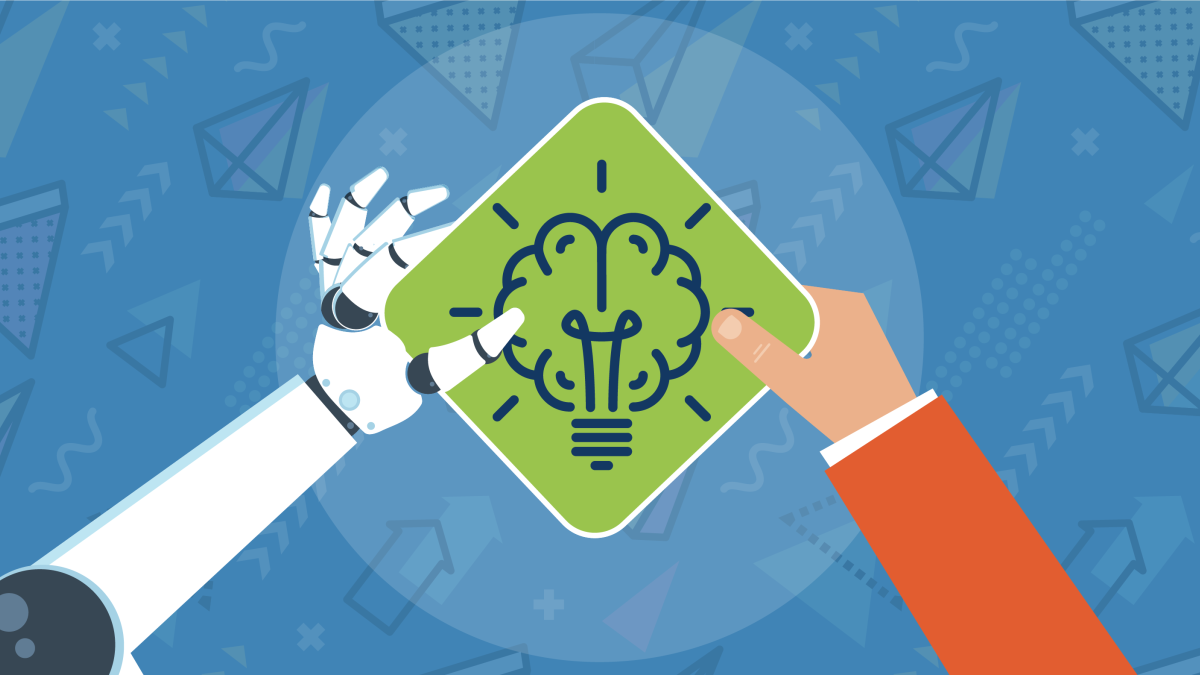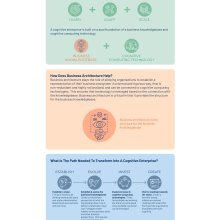Going digital: It’s on everyone’s mind. And business architecture can help. So, in this installment of StraightTalk, we’ll explore the concept of a cognitive enterprise: what it means, a vision of what can be, how to get there, and the important role business architecture plays to make it real.
And we brought in a guest star to help. We spoke with industry guru William Ulrich, President of TSG, Inc., Partner at Business Architecture Associates, and President and Co-Founder of the Business Architecture Guild.® This post is based on our recent interview with him.
Disclaimer: we’ve made some tiny adjustments for our typical StraightTalk-style: the headings represent StraightTalk asking the questions and our guest, Bill, responds in turn.
Make sure to check out the StraightTalk podcast 10-Minutes With William Ulrich: How Business Architecture Can Help Organizations to Become A Cognitive Enterprise.
Here goes.
What is a cognitive enterprise?
Bill: A cognitive enterprise is an organization that learns, adapts and scales on an evolutionary basis. It is based on a deep and expansive understanding of the business ecosystem in which that organization operates. This means it has a good understanding of what the organization does, how it delivers value to customers and stakeholders, the information it uses, the products it delivers, the policies it has and so forth.
A cognitive enterprise is built on a dual foundation of a business knowledgebase + cognitive computing technology.
P.S. This business knowledgebase of which we are speaking is the business architecture knowledgebase, which underscores the criticality of the business architecture discipline in making a cognitive enterprise a reality. If you’re new to business architecture, check out Posts No. 1, No. 17 and No. 18 for an overview.
Cognitive computing technology incorporates a cross-section of Artificial Intelligence (AI) and related technologies. It’s not one thing but a number of things that allow an organization to work in an adaptive learning mode, which includes machine learning, deep learning, machine based-rules and so forth.
Tell us more about the benefits of a cognitive enterprise.
Bill: A cognitive enterprise is highly efficient, highly effective and this increases over time based on its experiences. It also maintains an excellent level of customer satisfaction for its customers across the board.
Efficiencies are gained through dramatically increased levels of stakeholder and capability automation, so over time you’ll see stakeholders moving from people-led to machine-led, but there is a whole spectrum where it moves through machine-assisted, to machine-led, to machine-controlled. Correspondingly, the capabilities that stakeholders engage in become more and more automated.
Effectiveness is delivered through dramatically improved strategy execution and enhanced learning and adaptability. For example, when an organization sets an objective, there is a rapid assessment across the organization that is supported by these types of technologies and the knowledgebase. It would tell us what the impacts are of that objective and some of the pathways to deliver it including the framing of programs and projects. (Yes, we are talking about automating architecture impact assessments and translation into initiatives here!)
Collectively, as we improve efficiency and effectiveness, those will lead to increased customer satisfaction.
Give us some examples.
Bill: Let’s say you are rolling out a new product to market in a large enterprise across multiple divisions, a virtual product manager could help you design and construct a good product more quickly and eliminate bad ideas more quickly.
Similarly, a virtual program manager could assist or take over the role of framing initiatives, aligning them, reducing redundancies, reducing conflicts and so forth.
What are some of the challenges you’ve seen organizations having – or that you anticipate they will have – as they transform to become a cognitive enterprise?
Bill: There are two key challenges.
- A Cohesive Long-Term Vision – The first challenge for organizations is putting together a cohesive long-term vision that can stand up to shifting political winds. One of the challenges in many organizations today, partially dependent upon their specific economic and geographic climate, is the inability to manage a long-term vision past quarterly or annual returns. The vision must be sustained because becoming a cognitive enterprise does not happen overnight, it evolves gradually and over time.
- Lack of Buy-In to the Business Knowledgebase Concept – We can imagine that a lot of organizations will jump to the cognitive computing technologies and plug them in piecemeal without any sort of coordinated or cohesive understanding of the organization. The pushback on the knowledgebase itself is probably going to be a second obstacle.
What role does business architecture play in enabling a cognitive enterprise?
Bill: As mentioned earlier, a cognitive enterprise is based on the dual foundation of a business knowledgebase and cognitive computing technologies. And, the business knowledgebase itself is framed on a business architecture framework – a formal perspective as defined by the Business Architecture Guild.® The knowledgebase needs to have a very defined understanding of an organization, and to do that a very rigorously defined and enforced set of principles are necessary to define things like capabilities, value streams, stakeholders, information, organizational structure and so forth. If an organization veers widely from these principles and creates a haphazard, highly redundant, inconsistent, poorly aligned perspective, it will no longer serve as a baseline for a cognitive enterprise, but rather will become a hindrance.
Business architecture plays the role of allowing organizations to establish a representation of their business ecosystem in a formal and rigorous way, that is non-redundant and highly rationalized, and can be connected to cognitive computing technologies. This ensures that technology is leveraged based on the connection with the knowledgebase. Business architecture is critical in that it provides the structure for the business knowledgebase.
So, where should an organization start?
Bill: There are a few key steps an organization should follow to become a cognitive enterprise.
- Establish a vision. Everyone needs to be working towards the same end-state understanding. Remember that benefits are accrued over time though, so we need to sell the value proposition as well as the fact that value is accrued early and over time.
- Establish and evolve the business knowledgebase. It can take some time to create a rationalized perspective of what the organization does, how it delivers stakeholder value, how it engages stakeholders across business units and so forth. This requires some commitment to a formal business architecture framework.
- Explore and invest in cognitive computing technologies. Many of these technologies are evolving, but there are some very good ones out there today which can be leveraged.
- Chart a roadmap towards the vision. Create a benefits-based, milestone-oriented roadmap with clear KPIs. For example, if a business knowledgebase is established in phase 1, the KPIs associated with it should be defined, even if the knowledgebase is not yet connected to the cognitive computing technologies. Each year the organization should become more cognitive.
Check out the handy diagram below for a summary of all that.
Anything else?
Bill: The big idea here is that cognitive enterprise benefits accrue early and scale over time. So, establish portions of the business knowledgebase that allow planning and execution teams to begin reaping benefits, at least manually, although you’ll use some tooling, as you go through the automation of those same benefits. This allows you to build expertise and apply scenarios manually (like scenarios related to the virtual product manager and virtual project manager mentioned earlier), and then you’ll teach the cognitive tools and technologies those same methods.
While a roadmap to full maturity for a cognitive enterprise is a longer-term proposition, the journey delivers increasing value along the way. As you evolve you will begin obtaining benefits and as you build further, you will obtain more and more.
Finally, keep in mind that if your competitors are doing this and you start two years from now, you will be two years behind – there are no magic catch up points.
So, here is yet another selling point you can use to help build buy-in and adoption for business architecture. If your organization wants to become a cognitive enterprise, it requires a principled, business object-based business architecture knowledgebase as described in the BIZBOK®Guide. This is the foundation. It’s not optional and the time to start is now. (More on business objects here in Post No. 52.)
More Good Stuff…
10-Minutes With William Ulrich: How Business Architecture Can Help Organizations to Become A Cognitive Enterprise (StraightTalk podcast): Just in case you missed that link in the beginning, here it is again. You can listen to the podcast with William Ulrich on how business architecture can help organizations become a cognitive enterprise, which was the basis for this post.
5-Minutes With William Ulrich: How Business Architecture Drives IT Architecture Alignment and Transformation (StraightTalk podcast): Make sure to check out Bill’s other podcast on business architecture and IT architecture alignment.
P.S. Remember that our StraightTalk podcasts are now also available on your favorite audio platform like Apple, Spotify, Stitcher and more. Hooray!
The Cognitive Enterprise: Envisioning the Business of the Future (William Ulrich): A white paper by our guest star introducing the concept of the cognitive enterprise, the important role of business architecture, and steps for cognitive enterprise transformation.
Envisioning the Organization of the Future: The Cognitive Enterprise (William Ulrich/Cutter Consortium): A webinar by our guest star on the same.
Cognitive Computing: A Brief Guide for Game Changers (Peter Fingar): A comprehensive synthesis of cognitive computing in one concise book.
The Future of Expertise (TED Talk): A TED talk by Dario Gil which discusses whether purely logical cognitive computers could avoid some of the blind spots made by human decision-makers. He also explores the future of cognitive computers as well as the uneasy question: could technology ever replace humans?

